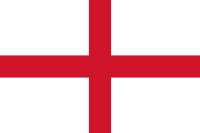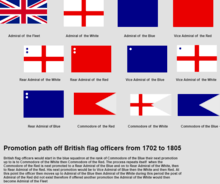Admiral (Royal Navy)
| Admiral | |
|---|---|
 Flag of an admiral, Royal Navy. | |
|
The sleeve lace, of a Royal Navy admiral. | |
|
The stars, and shoulder boards, of a Royal Navy admiral. | |
| Country |
|
| Service branch | |
| Abbreviation | ADM |
| Rank | Four-star |
| NATO rank | OF-9 |
| Non-NATO rank | 9 |
| Next higher rank | Admiral of the Fleet |
| Next lower rank | Vice admiral |
| Equivalent ranks | General, United Kingdom |
Admiral is a senior rank of the Royal Navy of the United Kingdom, which equates to the NATO rank code OF-9, outranked only by the rank admiral of the fleet. Royal Navy officers holding the ranks of rear admiral, vice admiral and admiral of the fleet are sometimes considered generically to be admirals. The rank of admiral is currently the highest rank to which an officer in the Royal Navy can be promoted, admiral of the fleet being in abeyance.
History
The first admirals from 1224 to 1525
King Henry III of England appointed the first known English Admiral Sir Richard de Lucy on 29 August 1224,[1] he was followed by a Sir Thomas Moulton in 1264,[1] he also held the title of Keeper of the Sea and Sea Ports he was succeeded by Sir William de Leybourne, (the son of Sir Roger de Leybourne) as Admiral of the Sea of the King of England being appointed in 1286 effectively Admiral of the Navy [2] he held the rank of admiral until 1294[1] serving under King Edward I of England. As the English Navy was expanding towards the end of the thirteenth century, new appointments of admirals with specific geographic responsibilities were created, Sir John de Botetourt was appointed Admiral of the North in 1294 this command lasted until 1412.[1] Also in the same year the king appointed Sir William de Laybourne the dual commands of Admiral of the South, (1294-1412) and Admiral of the West, (1294-1412). In 1364 the post of Admiral of the North and West was created until 1414.[1] Beginning in 1408 these admirals responsibilities were gradually absorbed by the office of the High Admiral of England, Ireland and Aquitaine (later Lord Admiral of England) leading to a centralized command the process ended in 1414.
Introduction of vice and rear admirals from 1525
The Royal Navy has had vice and rear admirals since at least the 16th century. When in command of the fleet, the admiral would be in either the lead or the middle portion of the fleet. When the admiral commanded from the middle portion of the fleet his deputy, the vice admiral, would be in the leading portion or van. Below him was another admiral at the rear of the fleet, called rear admiral.
Squadron admirals of the colour from 1570
In Elizabethan times the fleet grew large enough to be organised into squadrons. The squadron's admiral flew a red ensign, the vice admirals white, and the rear admirals blue on the aft mast of his ship. As the squadrons grew, each was eventually commanded by an admiral (with vice admirals and rear admirals commanding sections) and the official ranks became admiral of the white and so forth, however each admirals command flags were different and changed over time.
The squadrons ranked in order red, white, and blue, with admirals ranked according to their squadron:
- Admiral of the Fleet (union flag)
- Admiral of the Red (post not created till 1805)
- Admiral of the white
- Admiral of the blue
- Vice admiral of the red
- Vice admiral of the white
- Vice admiral of the blue
- Rear admiral of the red
- Rear admiral of the white
- Rear admiral of the blue
- Commodore of the red
- Commodore of the white
- Commodore of the blue
Promotion path of admirals from 1702 to 1864

Promotion up the ladder was in accordance with seniority in the rank of post-captain, and rank was held for life, so the only way to be promoted was for the person above on the list to die or resign. In 1747 the Admiralty restored an element of merit selection to this process by introducing the concept of yellow admirals (formally known as granting an officer the position of 'Rear-Admiral without distinction of squadron'), being captains promoted to flag rank on the understanding that they would immediately retire on half-pay.[3][4] This was the navy's first attempt at superannuating older officers.[5] They were often assigned to shore-based administrative roles, such as commander of a port or commissioner of one of the Royal Dockyards.
Interregnum 1649 to present day

During the Interregnum, the rank of admiral was replaced by that of general at sea.In the 18th century, the original nine ranks began to be filled by more than one man per rank, although the rank of admiral of the red was always filled by only one man and was known as Admiral of the Fleet. After the Battle of Trafalgar in 1805 the rank of admiral of the red was introduced.[6] The number of officers holding each rank steadily increased throughout the 18th and early-19th centuries; in 1769 there were 29 admirals of various grades, by the close of the Napoleonic Wars in 1816 there were 190 admirals in service. Thereafter the number of admirals was reduced and in 1853 there were 79 admirals.
Although admirals were promoted according to strict seniority, appointments to command were made at the discretion of the Board of Admiralty. As there were invariably more admirals in service than there were postings, many admirals remained unemployed, especially in peacetime.
The organisation of the fleet into coloured squadrons was finally abandoned in 1864. The Red Ensign was allocated to the Merchant Navy, the White Ensign became the flag of the Royal Navy, and the Blue Ensign was allocated to the naval reserve and naval auxiliary vessels.
The 18th- and 19th-century British Navy also maintained a positional rank known as port admiral. A port admiral was typically a veteran captain who served as the shore commander of a British naval port and was in charge of supplying, refitting, and maintaining the ships docked at harbour.
The problem of promoting strictly by seniority was well illustrated by the case of Provo Wallis who served (including time being carried on the books while still a child) for 96 years. When he died in 1892 four admirals under him could immediately be promoted.[7]
In 1996, the rank of admiral of the fleet was put in abeyance in peacetime, except for members of the Royal family but was resurrected in 2014 for the appointment of Lord Boyce. Admirals of the fleet continue to hold their rank on the active list for life.
Rank insignia and personal flag
The current ranks are rear admiral, vice admiral, admiral and admiral of the fleet, also known as flag ranks because admirals, known as flag officers, are entitled to fly a personal flag. An admiral of the fleet flies a Union Flag at the masthead, while an admiral flies a St George's cross (red cross on white). Vice admirals and rear admirals fly a St George's cross with one or two red discs in the hoist, respectively.
The rank of admiral itself is shown in its sleeve lace by a broad band with three narrower bands. Since 2001 it has been designated a four-star rank when the number of stars on the shoulder board was increased to four.[8][9]
 Sleeve lace
Sleeve lace Shoulder board
Shoulder board Shoulder board prior to 2001
Shoulder board prior to 2001 World War II admiral's shoulder board
World War II admiral's shoulder board Command flag for an admiral from 1864.
Command flag for an admiral from 1864.
History command flags
Prior to 1864 the Royal Navy was divided into colored squadrons which determined his career path. The command flags flown by an Admiral changed a number of times during this period, there was no Admiral of the Red rank until that post was introduced in 1805 prior to this the highest rank an admiral could attain to was Vice-Admiral of Red who then flew the plain red flag. The next promotion step up from that was to Admiral of the Fleet. Post 1805 until 1864 the Vice Admiral of the Red flag changed to a plain red flag with a single white ball in the upper left canton.[10]
See also
References
- 1 2 3 4 5 Houbraken, Jacobus; Thoyras, Paul de Rapin; Vertue, George (1747). The History of England, A List of Admirals of England, 1228-1745. J. and P. Knapton. p. 270.
- ↑ "THE BEGINNINGS OF ENGLISH MARITIME ENTERPRISE". History. 13 (50): 97–106. 1928. doi:10.2307/24400638. JSTOR 24400638.
- ↑ Millar, Stephen (2008). "Promotion in the flag ranks of the Royal Navy During the Napoleonic Wars". Retrieved 23 December 2016.
- ↑ Rodger 1986, p.299
- ↑ N.A.M. Rodger (2004) The Command of the Ocean: A Naval History of Britain 1649-11815 London, Allen Lane, 325-6
- ↑ <http://www.napoleon-series.org/military/organization/Britain/Navy/c_flagranks.html Promotion in the Flag Ranks in the Royal Navy during the Napoleonic Wars>
- ↑ Salt Indeed: The Amazing Career of Lieutenant Provo Wallis of HMS Shannon
- ↑ royalnavy.mod.uk Archived 27 September 2007 at the Wayback Machine. – Uniforms and Badges of Rank: Admiral
- ↑ Admiral is a four-star rank in NATO, Commonwealth and, since 2001, the Royal Navy (Refer UK DCI (Joint Service) 125/2001).
- ↑ Perrin, W. G. (William Gordon) (1922). "IV:Flags of Command". British flags, their early history, and their development at sea; with an account of the origin of the flag as a national device. Cambridge, England: Cambridge : The University Press. pp. 73–109.
Sources
- Archives, National The. (2017). "Trafalgar Ancestors, Glossary". nationalarchives.gov.uk. National Archives. London. England
- Bothwell, James (2004). Edward III and the English Peerage: Royal Patronage, Social Mobility, and Political Control in Fourteenth-century England. Boydell Press. ISBN 9781843830474.
- Houbraken, Jacobus. Thoyras, Paul de Rapin. Vertue, George. (1747). The History of England, A List of Admirals of England (1224-1745). England. Kanpton. P and J.
- Perrin, W. G. (William Gordon) (1922). "IV:Flags of Command". British flags, their early history, and their development at sea; with an account of the origin of the flag as a national device. Cambridge, England: Cambridge : The University Press.
External links
- Squadronal colours factsheet from the Royal Naval museum.
| NATO rank code | Student officer | OF-1 | OF-2 | OF-3 | OF-4 | OF-5 | OF-6 * |
OF-7 ** |
OF-8 *** |
OF-9 **** |
OF-10 ***** | ||
|---|---|---|---|---|---|---|---|---|---|---|---|---|---|
| Royal Navy | O Cdt | Mid | SLt | Lt | Lt Cdr | Cdr | Capt | Cdre | RAdm (list) |
VAdm (list) |
Adm (list) |
Adm of the Fleet | |
| Royal Marines | O Cdt | 2Lt | Lt | Capt | Maj | Lt Col | Col | Brig | Maj-Gen | Lt-Gen | Gen (list) |
Capt-Gen | |
| Army | O Cdt | 2Lt | Lt | Capt | Maj | Lt Col | Col | Brig | Maj-Gen (list) |
Lt-Gen (list) |
Gen (list) |
Fd Mshl | |
| Royal Air Force | Off Cdt / SO | APO / Plt Off | Fg Off | Flt Lt | Sqn Ldr | Wg Cdr | Gp Capt | Air Cdre | AVM | Air Mshl | Air Chf Mshl (list) |
Mshl of the RAF | |